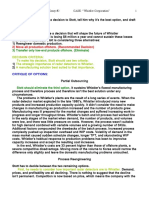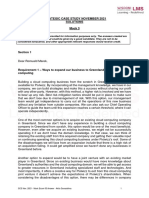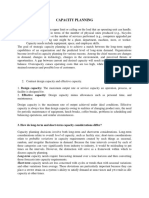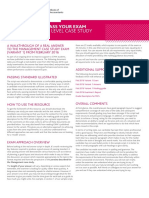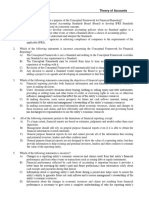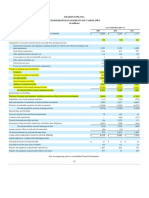Cgmax Management Case Study May 2019 Exam Answers: Section 1 Expanding Production
Cgmax Management Case Study May 2019 Exam Answers: Section 1 Expanding Production
Uploaded by
sangCopyright:
Available Formats
Cgmax Management Case Study May 2019 Exam Answers: Section 1 Expanding Production
Cgmax Management Case Study May 2019 Exam Answers: Section 1 Expanding Production
Uploaded by
sangOriginal Title
Copyright
Available Formats
Share this document
Did you find this document useful?
Is this content inappropriate?
Copyright:
Available Formats
Cgmax Management Case Study May 2019 Exam Answers: Section 1 Expanding Production
Cgmax Management Case Study May 2019 Exam Answers: Section 1 Expanding Production
Uploaded by
sangCopyright:
Available Formats
CGMAX MANAGEMENT CASE STUDY MAY 2019 EXAM
ANSWERS
Variant 1
Section 1
Expanding production
The following approaches are worth considering:
a) Existing cash resources. We currently have significant levels of cash. It might
be worth considering investing some of that in our project. It should, however,
be borne in mind that this cash is an asset that has already been funded by
Jord, through debt, equity or a combination of the two. Existing cash balances
are not, therefore, an inexpensive source of funds. It would, however, have the
advantage of eliminating the costs associated with raising finance. There could
be problems if we divert funds that are required for some other purpose. We
could, for example, find it necessary to raise additional cash in the future and
so we will only be delaying those costs.
b) Debt. The business has no existing debt or gearing, but is consistently
profitable and also has a number of assets (property, plant, inventory and trade
receivable) which could be provided as security to a bank. Therefore, we should
be able to raise a significant sum of money in this way. The cheapest debt is
usually provided by securing the debt against assets, so we should look at that
option first, and then a cash flow loan based on our historical profit/cash
generation which will be slightly more expensive. In terms of disadvantages, we
will need to pay these loans back out of cash flow over several years, and
interest will be charged annually, although interest can be offset against the
organisations tax liability.
c) Equity. The final option is by raising equity from new investors. This will affect
the shareholders more than the company as it will dilute the percentage of the
business they currently have, but the new shareholder may require a certain
level of control of management decisions which could be undesirable. They
might also want to sell the business in the future to realise their investment. A
cheaper and potentially more straightforward way of raising equity would be a
rights issue for existing shareholders. This carries no implications for the
company itself, shareholders would retain their relative share, and is almost the
same as the cancellation of the dividend noted in b) above, as cancelling a
dividend or putting cash in amounts to the same thing. For example, if we are
due to pay a dividend of $100 but need $100 investment from the same
shareholder who would receive the dividend, then cancelling the dividend
amounts to the same thing.
CIMA 2019. No reproduction without prior consent.
Just-in-time and expansion plans
A just-in-time (JIT) system depends upon seamless working within an organisation
and between an organisation and its suppliers.
In the short term, expanding by 25% will impact on our ability to operate the JIT
systems in the way we do now. Efficiencies will be lost whilst getting used to operating
at the new higher production levels.
The extent to which our approach is disrupted depends on the effectiveness of our
management team in expanding in an ordered and effective manner. It also depends
on the choice we make between expanding production via an extension of the current
site or expanding to a new distant location.
Expansion of the existing site seems most likely to minimise the impact on JIT
working. Although it will take time to train new staff members to get up to speed and
become fully efficient in their ways of working, ordering systems and linkages between
different stages of production are likely to remain similar. In that scenario we might
predict that, although there are likely to be short-term issues with preserving just-in-
time working, they are unlikely to persist long-term.
If, however, we expand by taking on a new site that is geographically some distance
from the current operations, JIT working is likely to be more fundamentally impacted.
The efficiency impact is likely to be higher, however, if the distant site is chosen. There
will be an impact arising from the logistics of how the two sites work together.
Depending on which elements of production are located at the distant site, there could
be issues with transporting raw materials or work in progress between the sites, issues
with communication between the two sites and by physically splitting the workforce
inefficiencies arising from any members of staff who need to operate at both sites – for
example, potentially our quality control team. This may lead us to choose to expand
the current site as a more efficient option if there aren’t any other issues that may
make that a sub-optimal choice when we investigate the details of this expansion.
Whichever site we choose there will be an impact on suppliers, and we will have to talk
to them about how quickly they can meet higher levels of demand. Some suppliers may
find it easy to quickly flex their output to meet our new levels of demand, but for others
it may take time to meet the new levels of materials required.
Also, irrespective of the choice of site, if new machines are needed it will take time to
order those, implement them and train staff in their use. All these implications will
impact our just in time approach regardless of whether we expand the current site or
develop a site further away.
We will, however, seek to ensure efficiency is improved as soon as possible whichever
way we manage the expansion, and that JIT working resumes as soon as possible. Will
still strive to minimise waste and work fluidly as we always have. Therefore, I would
hope the impact would be short-term, and that over a longer time scale we can start to
return to the outstanding levels of efficiency we operate at now.
May 2019 2 CGMA Management Case Study Exam
Section 2
Risks of proceeding with each site
Site One
The voles
May 2019 3 CGMA Management Case Study Exam
As you know, at Jord we pride ourselves on our desire to care for the environment.
Choosing this site, this would really damage our reputation and brand on this front.
Even by doing everything we could to rehome the voles in as caring and safe way as
possible, we are still likely to experience bad publicity for our actions. In our risk
register, the environment risk, after mitigation, is already at a medium level and this is
only going to increase if we pursue this site.
There is also a risk that some of our staff will become disillusioned and demotivated, as
at least some of our staff are likely to be working for us because of our caring approach
to the environment. Quality of staff is a perceived risk, according to our register.
Losing key staff over this issue would only add to this risk which is already deemed to
be high.
Planning laws are another risk that we have currently highlighted. At the moment, this
is seen as low risk. However, it is likely to take longer to get agreement from the
planning authorities to enable us to begin work on this site, as they will clearly want us
to prove that we have a satisfactory method for rehoming the voles and they are likely
to be bombarded with protests from environmentalist groups. This can only lead to an
increase in risk to at least medium.
There is also a risk that the cost of rehoming the voles will eat into the likely return
from our investment.
There are, however, upside risks to us choosing this site. As this is the same site as our
current operations, there will be no additional costs of moving materials and part-
finished timber work to the other site and it should be easier for us to maintain target
stock levels and efficiencies.
Site Two
Operating from two sites
Working across two sites, even though they are only 5 km apart, will make it more
difficult to use our current efficient approach in the production and supply processes.
It will be more complicated, at least in the short term, to co-ordinate operations and
some of our processes may involve duplication over the two sites given that Site Two
will effectively be a smaller replica of our main site. This would, of course, adversely
impact on the efficiency of our operating processes, although some of this could be
mitigated over time.
There are likely to be increased costs of operating over two sites due to issues with
logistics. We know that the timber cutting function will remain at Site One so at the
very least there is the question of how cut timber will be transported between the two
sites and how this will potentially impact on time schedules and quality.
Quality assurance
By transporting timber between the two sites it increases the risk that it will be
damaged or delayed in transit, all of which will impact on the way Jord organises its
work. From a quality assurance perspective, we will need to ensure that the quality
control team working at the new site are trained to the same level as those at the
original site as this is a fundamental part of ensuring we produce a high quality,
reliably luxurious house product.
May 2019 4 CGMA Management Case Study Exam
There is an upside risk, however, with choosing this site in that we would preserve or
enhance our reputation by publicising the fact that we have chosen this option and we
didn’t want to disturb the voles from their natural habitat.
Communicating expansion plans with stakeholders
There are several stakeholders that will be interested in the expansion plans and will,
therefore, need to be communicated with.
Shareholders will be most interested in the expansion plans. There are few
shareholders in this business and, so, communication with them should not be
difficult. Some of the shareholders are members of the Larsson family and those who
work in the business are likely to already be aware of the plans. All shareholders should
be contacted with details of the planned expansion. This might most effectively be
done via a shareholders meeting or letter, outlining the rationale behind expansion and
why management think it would be good for the business.
Staff will also be extremely interested in the expansion plans and will need to be made
aware of the plans and how they are impacted upon at work. Although we won’t be able
to fill in all the details of exactly how roles will change at this point, we will be able to
give staff an idea of their initial plans, particularly with regards to recruiting new staff
and how training and managing those staff will be approached.
Suppliers will need to be informed of the plans, particularly as Jord has a close
relationship with suppliers, working on a just-in-time basis and utilising seamless
connections with suppliers to get the flow just right. Initial conversations should
involve understanding whether suppliers will be able to continue to meet demand at a
higher level and include early discussions about how Jord and its suppliers may
continue to work closely together to preserve the excellent systems of production at
higher quantities.
Environmentalist groups and the local media will also be interested in our
plans, particularly if we pick Site One for our expansion. We will need to carefully
explain how the impact on the environment will be managed and how the Corvolan
pine voles will be safely rehoused. Good communication is essential here to prevent
protests from the environmentalists and any damage to our reputation. One
appropriate communication technique for this information may be a press release.
Section 3
Email to shareholder
May 2019 5 CGMA Management Case Study Exam
The comparison lists three performance measures for each site. The concern appears
to be that the site with the better NVP has the poorer discounted payback and IRR.
That problem is readily dealt with because NVP is the only criterion that directly
measures the impact of a decision on shareholder wealth. Site Two has the higher NPV
and so it is the superior investment. Any counterarguments based on IRR or
discounted payback will be confusing.
IRR measures the return that is being earned on the funds invested in the project. Any
project that has an IRR that exceeds the required rate of return will have a positive
NPV. That means that Jord should accept both projects if it can. Clearly it cannot, in
this case, because the two sites are mutually exclusive investments. Acquiring one
would mean that there was no need for the other.
When comparing mutually exclusive investments, IRR can give misleading results
because it ignores the scale of a project. Scale is usually related to the amount invested
and the duration of the project. In this case, Site One offers a higher rate of return, but
on an initial investment that is C$2 million smaller. In absolute terms, Site Two offers
a larger increase in wealth because it gives a good return on a larger initial investment.
The discounted payback of Site One is shorter, but that does not necessarily make it a
better investment. Certainly, a project that offers a rapid discounted payment can be
expected to offer significant inflows in the early years of the project. Companies may
consider the payback criterion when aiming to manage their long-term cash flows.
However, a more rapid payback does not outweigh a larger NPV because discounted
payback is not a direct measure of the impact on shareholder wealth.
Project team to manage expansion, tools and techniques
Jord will need to employ project management tools and techniques to ensure the
expansion project goes well.
This will involve recruiting the right members of staff to a team of people, brought
together to action the expansion. The team may involve current members of staff and
external people brought in to help where we do not have the expertise or manpower
alone. Ideally, the team would comprise people with different skills and abilities in the
right balance to get the job done. It may be beneficial to include members of staff from
all five of our operating divisions, as all divisions will be impacted to some extent by
the expansion as, whilst they type of work they are doing shouldn’t change, the amount
of work passing through each division will increase by up to 25% compared to what it
is used to although it is clearly recognised that additional staff will need to be recruited
for each division.
Once the team is congregated there are several tools that can be used to assist the
process. Risks will need to be assessed and managed using tools such as ‘TARA’ where
risks are assessed for probability and impact with plans made accordingly to transfer,
avoid, reduce or accept the risks arising from operations.
A work breakdown schedule will be useful to organise the work to be done into more
manageable sections and a Gantt chart could show a useful visual representation of the
work schedule, including potentially elements of the project that are inter-dependent.
A Gantt chart aids clarity and makes complicated projects simpler to view and manage.
Scenario planning can be a useful way to understand how uncertainties may impact on
the final project outcome and in this scenario could be helpful in ascertaining how high
costs could go if certain circumstances arise. If certain scenarios are very expensive
then we will need to act to make sure they don’t arise.
May 2019 6 CGMA Management Case Study Exam
Finally, project management software could be very useful to Jord, as an organisation
very comfortable and familiar with using software in house scheduling it could be
extremely helpful to use similar software systems adapted for this project. Software
can be useful to enhance collaborative working across the project with document
sharing, budget management, time scheduling, monitoring and communication all
useful roles that can be completed with effective software.
Section 4
The need to capitalise the leased assets in the statement of financial position, along
with their associated liability, is governed by IFRS 16 Leases, which came into force for
May 2019 7 CGMA Management Case Study Exam
accounting periods beginning on or after 1 January 2019, which makes it relevant to
Jord.
IFRS 16 requires that leases be accounted for on the basis of their economic substance
rather than their legal form. Jord will not own these assets in a legal sense, but it will
control them for the duration of the lease. IFRS 16 requires that the present value of
the future lease payments be calculated at the start of the lease and for the present
value to be capitalised as an asset and a liability. The asset will appear under PPE and
the liability will be split between current and non-current liabilities, depending on
whether they are due within or after 12 months.
Unlike previous standards, IFRS 16 does not permit any discretion over the
interpretation of the lease agreement. The fact that a lease has been signed requires
that the value of the lease should be capitalised, with the asset being depreciated over
the shorter of the lease term and the asset’s useful life. The liability will be adjusted for
the lease payments and the interest accruing on the liability. The categorical treatment
of all leases in the same manner is due to the need to eliminate opportunities for the
distortion of the financial statements through creative accounting. Historically, leases
have been misclassified by some companies who wished to minimise their gearing
ratios. Indeed, financial institutions have developed lease in the past that were
designed to enable companies to manipulate their financial statements and understate
their gearing.
If Jord could be permitted to have the lease flow through the statement of profit or
loss, as Theo wishes, then the shareholders could be misled as to the company’s true
financial position. The future lease payments would be just as much a commitment as
the future payments of capital and interest on a loan. Excluding the present value of
the payments from the statement of financial position would create the impression of a
lean and efficient enterprise, with little in the way of either PPE or debt.
Communication with and training of new staff
The new members of staff will represent around 15% of our overall workforce. It is
important, therefore, that we bring them on board as efficiently as possible, to
minimise the settling down process. It will be important to get new staff up to speed
quickly with Jord ways of working to ensure the costs are managed and our production
schedules are not jeopardised.
A programme should be devised to train new staff, and those members of staff involved
in administering the training should be informed of the timings and the nature of what
is required. Existing staff will be useful to help train the new workforce, and techniques
such as mentoring and teaching whilst on the job will be effective. However, we haven’t
conducted a training programme of this size before so our human resources director,
Eva Edberg, will play a key role in identifying and scheduling the training required and
obtaining additional training resource where necessary. Eva will work with the finance
department to ensure that is run to budget and implemented smoothly.
Good communication throughout the process will be critical and presentations, team
meetings and communication of information by email will all be useful mechanisms to
ensure that staff have the information that they need, when they need it. It is
important to create an atmosphere where staff feel comfortable asking questions, so
ensuring the people at the top and the people responsible for training new staff are
approachable and helpful is an essential part of the process.
May 2019 8 CGMA Management Case Study Exam
Performance targets
Although Jord is likely to want to use the same or similar performance measures after
expansion, it is unlikely it would be optimal to use the same targets in the short-term
and if they do this could cause some demotivation amongst staff.
Efficiency levels are likely to drop in the short-term as people get used to working at
the new higher production levels. There will be new members of staff to train and they
cannot all be expected to reach Jord’s high standards of effective working immediately.
Both new and old members of staff will be discouraged if no account is taken of the
changing circumstances in the targets they are working to meet.
Some operations may also be adversely affected by the fact that we are now working
across two sites. For instance, timber cutting only occurs at one site meaning that
transportation between the two sites must be scheduled into workflows. It will be
necessary to increase the standard cycle time for the process being completed from
start to finish to take account of the movement of timber and other changes arising
when two sites are operational. Failure to include these changes make the old targets
unrealistic and therefore potentially ineffective drivers for staff.
It seems sensible to look again at targets provided to staff, adjusting for the anticipated
changes in short term efficiency. We may even want to put in place some different
performance measures from those currently used to encourage smooth transition to
higher levels of production.
Hopefully, then, in the long term, as Jord staff benefit from the learning curve effect,
things will return to a state that is as efficient as before and we may well find that
targets can return to their pre-expansion level once things have settled down.
If Jord takes no account of the new working situation and keeps efficiency and waste
targets at the same levels as they were before expansion there could be a significant
impact on morale which would further increase the challenges faced in this time of
change.
May 2019 9 CGMA Management Case Study Exam
You might also like
- Yexmarine Specimen ACCA SolutionDocument7 pagesYexmarine Specimen ACCA Solutionsheharyar.kgsNo ratings yet
- Operations Management 12th Edition Stevenson Solutions Manual DownloadDocument29 pagesOperations Management 12th Edition Stevenson Solutions Manual DownloadNancy Payton95% (20)
- Current Asset Management SolutionsDocument40 pagesCurrent Asset Management Solutionstseboblessing7No ratings yet
- Solution Manual For Managerial Economics 6th Edition Paul KeatDocument3 pagesSolution Manual For Managerial Economics 6th Edition Paul Keatalifertekin45% (11)
- Change Management for Beginners: Understanding Change Processes and Actively Shaping ThemFrom EverandChange Management for Beginners: Understanding Change Processes and Actively Shaping ThemRating: 4.5 out of 5 stars4.5/5 (3)
- 'Case Study Decision (Prove & State Format) SampleDocument3 pages'Case Study Decision (Prove & State Format) SampleBobbyNichols100% (1)
- Ch02 - Further Exercises - and - PointersDocument6 pagesCh02 - Further Exercises - and - Pointershadi electronic serat companyNo ratings yet
- Ch02 Further Exercises and Pointers 5eDocument4 pagesCh02 Further Exercises and Pointers 5eLubna Ahmed100% (1)
- Mock Exam 03 AnswerDocument10 pagesMock Exam 03 AnswerJeffrey KamNo ratings yet
- Integration: Mergers, Acquisitions, and Business Alliances Answers To End of Chapter Discussion QuestionsDocument43 pagesIntegration: Mergers, Acquisitions, and Business Alliances Answers To End of Chapter Discussion QuestionsMedhaNo ratings yet
- The Direction We Should PursueDocument11 pagesThe Direction We Should PursueKavinthan ShanmugarajahNo ratings yet
- Maintaining Long Term View During TurnaroundsDocument4 pagesMaintaining Long Term View During TurnaroundsmarianoNo ratings yet
- 1.what Are The Pros and Cons of Switching From Wage Rates To Piece-Rate Pay?Document5 pages1.what Are The Pros and Cons of Switching From Wage Rates To Piece-Rate Pay?Shanaya SinghaniyaNo ratings yet
- Unlocking The Performance Levers of Commercial UnderwritingDocument7 pagesUnlocking The Performance Levers of Commercial UnderwritingCognizantNo ratings yet
- Castillo Performance Task2Document5 pagesCastillo Performance Task2MoisesNo ratings yet
- Task No. 4Document4 pagesTask No. 4VenNo ratings yet
- CASE STUDY-g2Document11 pagesCASE STUDY-g2Kc-an Libo-onNo ratings yet
- Final CBMEC1Document3 pagesFinal CBMEC1unorthodoxv1No ratings yet
- Cma Masters - Questions & SolutionsDocument47 pagesCma Masters - Questions & SolutionsTawanda HerbertNo ratings yet
- AnswersDocument5 pagesAnswersVarudhini PatkiNo ratings yet
- Decision EngineeringDocument7 pagesDecision EngineeringutorrentNo ratings yet
- LS-Final Paper Part IV (Windows Updated)Document3 pagesLS-Final Paper Part IV (Windows Updated)Caloy GonzalesNo ratings yet
- Is A Full Internal Model A Step Too Far?Document4 pagesIs A Full Internal Model A Step Too Far?Ehli HibreNo ratings yet
- MSC301: Production Operations Management Long Take-Home AssignmentDocument6 pagesMSC301: Production Operations Management Long Take-Home AssignmentZerin Tasnim AnannaNo ratings yet
- Business Agility and The CloudDocument12 pagesBusiness Agility and The CloudcorneliomoragaNo ratings yet
- Acceleration ClaimsDocument48 pagesAcceleration ClaimsSelim KIZILASLANNo ratings yet
- Case StudyDocument9 pagesCase StudyMUSTAFANo ratings yet
- Adidas-Reebok M & A Case StudyDocument4 pagesAdidas-Reebok M & A Case StudyBryn GavaNo ratings yet
- Adidas-Reebok M & A Case StudyDocument4 pagesAdidas-Reebok M & A Case StudyBryn GavaNo ratings yet
- Tutorial 6 SolutionsDocument4 pagesTutorial 6 Solutionsmerita homasiNo ratings yet
- Factors Determining The Working CapitalDocument4 pagesFactors Determining The Working CapitalSanctaTiffanyNo ratings yet
- OpMan TQMDocument3 pagesOpMan TQMMia CasasNo ratings yet
- FFM12, CH 13, IM, 01-08-09Document20 pagesFFM12, CH 13, IM, 01-08-09seventeenlopez100% (1)
- T11 Exam Preseen Mock 2 (Suggested Answers)Document6 pagesT11 Exam Preseen Mock 2 (Suggested Answers)xinghe666No ratings yet
- 2Document10 pages2lixingcrrcNo ratings yet
- Financial Management: F9FM-MT2A-Z08-A Answers & Marking SchemeDocument8 pagesFinancial Management: F9FM-MT2A-Z08-A Answers & Marking SchemeErclanNo ratings yet
- Tutorial in Week 11 (Based On Week 10 Lecture) Beginning 14 May 2018 TOPIC: Executive Compensation Solutions Q1 AttachedDocument5 pagesTutorial in Week 11 (Based On Week 10 Lecture) Beginning 14 May 2018 TOPIC: Executive Compensation Solutions Q1 AttachedhabibNo ratings yet
- CAPACITY ManagementDocument4 pagesCAPACITY ManagementAongkon KadirNo ratings yet
- Downloadable Solution Manual For Managerial Economics 6th Edition Paul Keat Ch02 Keat6e 1Document3 pagesDownloadable Solution Manual For Managerial Economics 6th Edition Paul Keat Ch02 Keat6e 1Ana Krann0% (1)
- Best Practices in BYOD - CassDocument9 pagesBest Practices in BYOD - CassToni MiharjaNo ratings yet
- CIMA Case Study - May23 - Operational - Mock Exam A - AnswersDocument22 pagesCIMA Case Study - May23 - Operational - Mock Exam A - AnswersMd FerozNo ratings yet
- Aaa June '24 Mock Q1Document5 pagesAaa June '24 Mock Q1nofaNo ratings yet
- Chap 013Document66 pagesChap 013Zewudu Mekitie AdaneNo ratings yet
- Week 3 Lending Cases Copycat For MoodleDocument10 pagesWeek 3 Lending Cases Copycat For MoodleYee TanNo ratings yet
- AAPre Jun 24 Mock Ans 17Document3 pagesAAPre Jun 24 Mock Ans 17Phạm Việt BáchNo ratings yet
- September: 2018 Summary Points BY TAHA POPATIADocument4 pagesSeptember: 2018 Summary Points BY TAHA POPATIAPolin TeangNo ratings yet
- Ba 328 Q12Document2 pagesBa 328 Q12Karen Grace AntolijaoNo ratings yet
- AFM P4 Past Exams Summary AFM (P4)Document44 pagesAFM P4 Past Exams Summary AFM (P4)mudasruu1No ratings yet
- Limitations of Capital BudgetingDocument2 pagesLimitations of Capital BudgetingLJBernardoNo ratings yet
- P7irl 2008 Jun ADocument20 pagesP7irl 2008 Jun AAshreena BhantooNo ratings yet
- Tut 2Document5 pagesTut 2Steffen HoNo ratings yet
- P7int 2008 Jun A PDFDocument20 pagesP7int 2008 Jun A PDFhiruspoonNo ratings yet
- Accounting AnswerDocument10 pagesAccounting AnswerAnonymous fE2l3DzlNo ratings yet
- Concept of JITDocument9 pagesConcept of JITaaron765573No ratings yet
- Introduction and Goals of The FirmDocument7 pagesIntroduction and Goals of The FirmNipuna Thushara WijesekaraNo ratings yet
- Om - Location DecisionsDocument14 pagesOm - Location DecisionsMarissa C BautistaNo ratings yet
- A2 BST 2020 Jun P32Document16 pagesA2 BST 2020 Jun P32shajiagney2No ratings yet
- ACCA P3 Q.11 Joe Swift Transport - SolutionDocument4 pagesACCA P3 Q.11 Joe Swift Transport - SolutionHamdan NawazNo ratings yet
- 10 Things You Should Know About Business Continuity Management - Mea - 06Document3 pages10 Things You Should Know About Business Continuity Management - Mea - 06Ayman AliNo ratings yet
- IMA Brand Guidelines: D&A ConsultingDocument2 pagesIMA Brand Guidelines: D&A ConsultingsangNo ratings yet
- Data Analytic - CertificateDocument1 pageData Analytic - CertificatesangNo ratings yet
- Introduction To Project ManagementDocument3 pagesIntroduction To Project ManagementsangNo ratings yet
- Blockchain 101 by IMA Printable ScriptDocument14 pagesBlockchain 101 by IMA Printable ScriptsangNo ratings yet
- Blockchain 101 by ImaDocument3 pagesBlockchain 101 by ImasangNo ratings yet
- Introduction To Sap FicoDocument13 pagesIntroduction To Sap FicosangNo ratings yet
- Past CIMA TasksDocument11 pagesPast CIMA TaskssangNo ratings yet
- Cima-Tutorial - Screen GuideDocument64 pagesCima-Tutorial - Screen GuidesangNo ratings yet
- The Definitive Strategic Planning Guide 1Document30 pagesThe Definitive Strategic Planning Guide 1sangNo ratings yet
- Relevant IMA ResourcesDocument1 pageRelevant IMA ResourcessangNo ratings yet
- MCS - May 19 - StructuringDocument17 pagesMCS - May 19 - StructuringsangNo ratings yet
- HuskieMotorCo - 2016 - 2017Document485 pagesHuskieMotorCo - 2016 - 2017sangNo ratings yet
- Credit CPE:3.5: The Strategic Planning ProcessDocument2 pagesCredit CPE:3.5: The Strategic Planning ProcesssangNo ratings yet
- The Management Level Case Study: Helping You To Pass Your ExamDocument9 pagesThe Management Level Case Study: Helping You To Pass Your ExamsangNo ratings yet
- Planning For Case Study Success Using The SWOT Analysis - Management & GatewayDocument3 pagesPlanning For Case Study Success Using The SWOT Analysis - Management & GatewaysangNo ratings yet
- Scott Maw: UBS Global Consumer and Retail Conference March 8, 2018Document12 pagesScott Maw: UBS Global Consumer and Retail Conference March 8, 2018sangNo ratings yet
- Stage 1 Stage 2 Stage 3 Stage 4 Stage 5 Unit 120 120 120 120 120Document1 pageStage 1 Stage 2 Stage 3 Stage 4 Stage 5 Unit 120 120 120 120 120sangNo ratings yet
- Trends and Insights in The Global Hot Drinks Market: Powered by Passport From Euromonitor InternationalDocument29 pagesTrends and Insights in The Global Hot Drinks Market: Powered by Passport From Euromonitor InternationalsangNo ratings yet
- Top 100 Food & Beverage CompaniesDocument1 pageTop 100 Food & Beverage CompaniessangNo ratings yet
- Retained EarningsDocument24 pagesRetained EarningsravisankarNo ratings yet
- Complete English Batch Reading Comprehension: English by Vishal PariharDocument35 pagesComplete English Batch Reading Comprehension: English by Vishal PariharKartik VermaNo ratings yet
- Enrichment Learning Activity: Name: Date: Year and Section: Instructor: Module #: TopicDocument3 pagesEnrichment Learning Activity: Name: Date: Year and Section: Instructor: Module #: TopicImthe OneNo ratings yet
- 1 - Conceptual Framework Q PDFDocument6 pages1 - Conceptual Framework Q PDFandreamrieNo ratings yet
- Interest During ConstructionDocument90 pagesInterest During ConstructionAzzata HijabNo ratings yet
- Question Responses (2022-10-13)Document4 pagesQuestion Responses (2022-10-13)Amira SamirNo ratings yet
- Gam Chap 3Document9 pagesGam Chap 3Johanna VidadNo ratings yet
- Equity Securities and Associates ReviewerDocument45 pagesEquity Securities and Associates Reviewerjhie boter100% (1)
- Topics Covered: How Corporations Issue SecuritiesDocument7 pagesTopics Covered: How Corporations Issue SecuritiesTam DoNo ratings yet
- Rental Property Investment AnalysisDocument23 pagesRental Property Investment Analysissam100% (1)
- VP-7-227731121012-Rahul JoshiDocument36 pagesVP-7-227731121012-Rahul JoshiDharmeshdanidhariya5No ratings yet
- Overview of Financial ModelingDocument25 pagesOverview of Financial Modelingalanoud100% (2)
- Adv Acc-Final-May08Document19 pagesAdv Acc-Final-May08V SwaminathanNo ratings yet
- Case 1 MarriottDocument14 pagesCase 1 Marriotthimanshu sagar100% (1)
- Fsa TheoryDocument3 pagesFsa TheoryMj PacunayenNo ratings yet
- My Subscriptions Courses ACC410-Advanced Accounting Chapter 2 HomeworkDocument29 pagesMy Subscriptions Courses ACC410-Advanced Accounting Chapter 2 Homeworksuruth242No ratings yet
- FIN2004 Midterm Cheat Sheet PDFDocument4 pagesFIN2004 Midterm Cheat Sheet PDFPeixuan Zhuang100% (1)
- 2021-2022 Spring - Resit Exam 17.06.2022 (Solved)Document14 pages2021-2022 Spring - Resit Exam 17.06.2022 (Solved)tomasslrsNo ratings yet
- CG Fs OLDDocument49 pagesCG Fs OLDDine CapuaNo ratings yet
- ADV I Chapter 3 2009Document17 pagesADV I Chapter 3 2009temedebere100% (1)
- AKKU Annual Report 2018Document148 pagesAKKU Annual Report 2018TyasNo ratings yet
- 54 Priyanka Tiwari Comparative Study of Returns in Mutual Funds and Equity InvestmentDocument62 pages54 Priyanka Tiwari Comparative Study of Returns in Mutual Funds and Equity Investmentsaumitra orpeNo ratings yet
- Practical Questions: Ca - IpccDocument8 pagesPractical Questions: Ca - IpccazharnadviNo ratings yet
- Unit 7: Ind AS-40: Investment PropertyDocument13 pagesUnit 7: Ind AS-40: Investment PropertySavya SachiNo ratings yet
- Financial Accounting and Reporting Assignment 1 - Lesson 16 ExercisesDocument5 pagesFinancial Accounting and Reporting Assignment 1 - Lesson 16 ExercisesShilla Mae BalanceNo ratings yet
- 105 10 Amazon Financial StatementsDocument5 pages105 10 Amazon Financial StatementsCharles Vladimir SolvaskyNo ratings yet
- Prime Minister's Youth Business Loan: Pre-Feasibility StudyDocument18 pagesPrime Minister's Youth Business Loan: Pre-Feasibility StudyZakir AliNo ratings yet
- Acc pdf1Document25 pagesAcc pdf1kJSAksdjNo ratings yet
- REPORT On Venture CapitalDocument59 pagesREPORT On Venture CapitalSANDEEP ARORA88% (16)
- Financial Management - Formula SheetDocument8 pagesFinancial Management - Formula SheetHassleBustNo ratings yet





